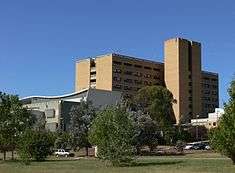Canberra Hospital
| Canberra Hospital | |
|---|---|
| ACT Health | |
 Canberra Hospital | |
| Geography | |
| Location | Yamba Drive, Woden Valley, Canberra, ACT, Australia |
| Coordinates | 35°20′43″S 149°06′03″E / 35.3454°S 149.1009°ECoordinates: 35°20′43″S 149°06′03″E / 35.3454°S 149.1009°E |
| Organisation | |
| Care system | Public |
| Hospital type | Teaching |
| Affiliated university | University of Canberra |
| Services | |
| Emergency department | Yes |
| Beds | 672 |
| History | |
| Founded | 1914 |
| Links | |
| Website | http://www.health.act.gov.au/c/health?a=da&did=10209377 |
| Lists | Hospitals in Australia |
Canberra Hospital is a public hospital located in Garran, Canberra, Australian Capital Territory. It is a tertiary level centre with 672 beds and caters to a population of about 550,000. It was formed when the Woden Valley Hospital and the Royal Canberra Hospital were amalgamated in 1991, and was renamed Canberra Hospital in 1996.[1]
It is the major teaching hospital for the Australian National University Medical School. It is also a teaching hospital for the University of Canberra's School of Nursing. Furthermore, the hospital has strong links with the John Curtin School of Medical Research. The hospital is also a major regional centre for Clinical Pastoral Education, offering courses through the Canberra and Region Centre for Spiritual Care and Clinical Pastoral Education in association with the Sydney College of Divinity and New South Wales College of Clinical Pastoral Education.
History
In May 1914 the Canberra Community Hospital, the first hospital for Canberra, was opened in Balmain Crescent, Acton with eight beds.[2] Tents were used to supplement the isolation ward. There were no obstetric facilities and obstetrics patients had to travel to the Queanbeyan hospital.[3]
In 1943 a new hospital was opened on the Acton Peninsula.[2] Construction of the building was commenced in 1940. In 1942, the United States Army Medical Corps took over construction and commissioned it as an American military hospital. It was a military hospital for only five months. In February 1943, the hospital buildings were handed over to the Canberra Hospital Board for the development of what in time became the Royal Canberra Hospital on Acton Peninsula.[3][4]
Woden Valley hospital buildings were constructed between 1969 and 1973.[5]
In 1973 the Woden Valley hospital opened and the first patients were admitted.[3]
In 1979 the Canberra Community Hospital was renamed the Royal Canberra Hospital.[4][6]
Services were transferred to the Woden Hospital when the Royal Canberra Hospital closed on 27 November 1991.[1][2]
In 1996 Woden Valley Hospital was renamed Canberra Hospital and its first IVF baby was born on 26 December 1996.[2]
On 13 July 1997 the superseded buildings on the Acton peninsular were demolished by implosion, killing a 12-year-old girl named Katie Bender who was hit by flying debris.[4]
In 2010, the second operating theatre capable of performing an MRI during brain surgery was commissioned.
Services & Campus
Canberra Hospital provides a wide range of services across more than 25 buildings on its campus. There is no map of the hospital campus at the main reception, so Volunteer Guides operate from the main reception, assisting visitors to navigate the hospital campus. You can also download a copy of the Canberra Hospital Campus Map.
See also
References
- 1 2 "About Canberra Hospital". ACT Government Health Information. ACT Health. Retrieved 2016-04-03.
- 1 2 3 4 "The Canberra Hospital - History of paediatric nursing". ACT Heath. Retrieved 2008-07-17.
- 1 2 3 "History". 1307.8 - Australian Capital Territory in Focus, 2006. Australian Bureau of Statistics. 12 September 2006. Retrieved 2008-07-17.
- 1 2 3 "Canberra Community Hospital, Acton, Australian Capital Territory: photograph from 1946". Demetrisu = Canberra Album. hdl:1885/336.
- ↑ "Image: Construction of Woden Valley Hospital, November 1969-1973". ACT Heritage Library. Retrieved 2008-07-17.
- ↑ "Curley, Sylvia (1898 - 1999)". Bright Sparcs Biographical entry. The University of Melbourne eScholarship Research Centre. 2007. Retrieved 2008-07-17.